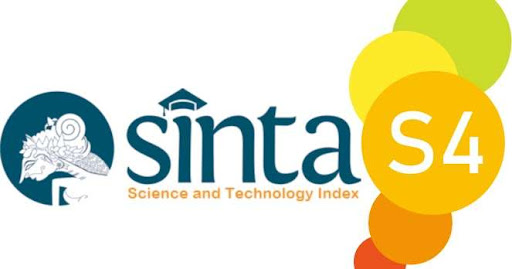Negative Traits of Lady of The Green Kirtle as Antagonist in C.S. Lewis’ The Silver Chair
DOI:
https://doi.org/10.36733/sphota.v17i2.12603Keywords:
antagonist, characterization, Narnia, The Silver ChairAbstract
An abstract should accompany each manuscript; it should be completely self-consistent (i.e., In children’s literature, protagonists are often highlighted as role models, while antagonists are frequently overlooked, despite their crucial role in creating conflict and shaping the plot. Thus, this study explores the characterization of the Lady of the Green Kirtle, the main antagonist in The Silver Chair by C.S. Lewis. An interactive, qualitative method, as described by Miles, Huberman, and Saldana, was employed in this research. As the main instrument, close reading of the novel was employed to identify and analyze specific subsequences containing the antagonist’s behaviors. The findings reveal that the Lady of the Green Kirtle is characterized by four main traits: manipulative, dominant, cruel, and dangerous. She employed her magic, lies, and violence to manipulate others and achieve her goals. Her presence greatly influences the direction of the plot and the challenges faced by the protagonists. This study demonstrates that examining antagonists can enhance our understanding of character roles in literature, particularly in children's stories.
References
Andriana, N., & Rohmah, O. (2019). The Character and Setting in the Novel About You by Tere Liye. INFERENCE: Journal of English Language Teaching, 2(2), 151–159.
Anggraeni, E. (2016). Patriarchal Practices in Roald Dahl. Universitas Diponegoro.
Annuri, N. H., Pratama, N. J., & Khusniyah, N. L. (2024). Moral Messages Analysis on Antoine de Saint-Exupéry’s The Little Prince and Its Potential in Shaping Young Readers’ Character. DISCOURSE: Indonesian Journal of Social Studies and Education, 1(3), 190–195. https://doi.org/10.69875/djosse.v1i3.110
Apriliyani, N. Y. A., Nurdin, & Restorningroem. (2024). The Role of Literature in Early Childhood Education (Case Study of Kindergarten X Bekasi). Multidisciplary Journal of Systemic and Innovative Research, 1(1), 21–25.
Arafah, B., Room, F., Suryadi, R., La Ode, M. I. H. B., Juniardi, Y., & Takwa. (2024). Character Education Values in Pullman’s The Golden Compass. Journal of Language Teaching and Research, 15(1), 246–254. https://doi.org/10.17507/jltr.1501.27
Ariyani, L. T., Suwastini, N. K. A., Artini, N. N., Agustini, D. A. E., Rismadewi, N. W. M., Pradana, W. R. Y., & Rewa, G. A. B. (2025). Negative Traits of Queen Jadis in C. S. Lewis’ the Chronicles of Narnia: The Magician’s Nephew. LITERA KULTURA: Journal of Literary and Cultural Studies, 13(2), 87–97. https://ejournal.unesa.ac.id/index.php/litera-kultura/article/view/70563
Azharinas, G., Izzani, B., & Mala Rohmana, W. I. (2024). Psychological Approach of Jadis’ Act of Violence in Novel Entitled Narnia: The Lion, The Witch, and The Wardrobe by C.S. Lewis. Seltics Journal: Scope of English Language Teaching Literature and Linguistics, 7(1), 72–77. https://doi.org/10.46918/seltics.v7i1.2104
Bella, H. A. Z., Suwastini, N. K. A., & Jayantini, I. G. A. S. R. (2023). Oedipus Complex Reflected through Edmund Pevensie’s Characters in C.S. Lewis’s The Lion, The Witch, and The Wardrobe. Proceedings of the 3rd International Conference Entitled Language, Literary, And Cultural Studies, ICON LATERALS 2022, 05–06 November 2022, Malang, Indonesia. https://doi.org/10.4108/eai.5-11-2022.2329457
Bordwell, D., Thompson, K., & Smith, J. (2017). Film Art: Creativity, Technology, and Business. In Film Art: An Introduction (11th ed.). McGraw Hill.
Charima, D. (2020). The Analysis Ecranisation of Peter’s Charaterization Affected By His Conflicts in the Novel and in the Film Entitled the Chronicles of Narnia: Prince Caspian. Journal of Language and Literature, 8(2), 131–145. https://doi.org/10.35760/jll.2020.v8i2.2978
Dewi, N. K. K., Suwastini, N. K. A., & Jayantini, I. G. A. S. R. (2021). The characterization of Amanda Collier in Nicholas Sparks’ The Best of Me (2011). International Journal of Language and Literature, 5(3), 123–136. https://ejournal.undiksha.ac.id/index.php/IJLL/article/view/34934/19961
Dewi, N. K. L., Resen, I. W., & Sidhakarya, W. (2021). Analysis of Liberal Feminism in the Novel Mulan’s Secret Plan by Tessa Roehl. Ournal of Humanities, Social Science, Public Administration and Management (HUSOCPUMENT), 1(4), 241–247.
Emmanuel, I. F. (2022). Children’s Literature and Its Relevance for Character Formation and Developments. Journal of Foreign Language Teaching and Learning, 7(2), 285–299. https://doi.org/https://doi.org/10.18196/ftl.v7i2.14676 Abstract
Fadly, Y., & Amelia, C. (2023). A concise overview of the characters in Danny Cannon’s movie “Goal.” Prosiding Seminar Nasional Dan Internasional Universitas Dharmawangsa.
Fitri, N. (2018). The Characterization of Lord Voldemort in Novel Harry Potter and The Half-Blood Prince by J.K Rowling Seen from Psychoanalysis. Tell Journal, 6(1), 14–20.
Fitria, T. N. (2021). Characterization Analysis of the Main Character in “Hichki” Movie. Vivid: Journal of Language and Literature, 10(1), 6–17. https://doi.org/10.25077/vj.10.1.6-17.2021
Gafar, A., & Maryani, N. (2020). Watak Protagonis Tokoh Riri dalam Novel Saat Hati Telah Memilih Karya Mira W. Aksara: Jurnal Ilmiah Pendidikan Bahasa Dan Sastra Indonesia, 4(1), 1–8. https://doi.org/10.33087/aksara.v4i1.161
Gill, R. (1995). Mastering English literature (Second Edi). Palgrave.
Hamby, S. (2017). On defining violence, and why it matters. Psychology of Violence, 7(2), 167–180. https://doi.org/10.1037/vio0000117
Haugaard, M. (2018). What is authority? Journal of Classical Sociology, 18(2), 104–132. https://doi.org/10.1177/1468795X17723737
Hissan, W. S. M. (2012). An analysis of the children’s characters in Roald Dahl’s novel: Charlie and the chocolate factory. Indonesian Journal of Applied Linguistics, 2(1), 83–92. https://doi.org/10.17509/ijal.v2i1.107
Hizraini, A. A., Winarni, R., Yamtinah, S., & Suriansyah, A. (2022). Character Education in a Children’s Short Story Book entitled “Linda Punya Kebun Papaya.” Al-Ishlah: Jurnal Pendidikan, 14(2), 1381–1392.
Junaid, S. (2017). Children’s Literature in Empowering Children Character Building. Elite: English and Literature Journal, 4(01), 109–125. https://doi.org/https://doi.org/10.24252/elite.v4i1a10
Kakkar, H., & Sivanathan, N. (2022). The impact of leader dominance on employees’ zero-sum mindset and helping behavior. Journal of Applied Psychology, 107(10), 1706–1724. https://doi.org/10.1037/apl0000980
Kaniasari, F., & Saragih, G. (2019). Moral Values and Ethics in the Children’s Picture Book Of Thee I Sing: A Letter to My Daughters by Barack Obama. INFERENCE: Journal of English Language Teaching, 2(2), 138–144.
Khayatovna, N. M., & Davronova, T. D. (2024). Interpretation of Protagonist and Antagonist in The Works of Agatha Christie. Web of Humanities: Journal of Social Science and Humanitarian Research, 2(1), 1–4.
Kheirbek, T. H., & Ezzat, R. A. (2020). The Use and Symbolism of Animals in The Wonderful Wizard of Oz. Language Literacy: Journal of Linguistics, Literature, and Language Teaching, 4(2), 203–211. https://doi.org/10.30743/ll.v4i2.3059
Kristiyani, M. (2008). The influence of bad treatment on Edmund’s personality developments seen in C.S. Lewis’ The Chronichles of Narnia: The Lion, the Witch and the Wardrobe. Universitas Sanata Dharma.
Lalenoh, R. P. (2018). David Fincher’s Gone Girl: Description of Psychopathic Symptoms Reflected on Amy Elliot Dunne’s Character. TOTOBUANG, 5(2), 187–198. https://doi.org/10.26499/ttbng.v5i2.32
Mariana, A. (2023). Literary Psychology: Main Character Analysis of “The Feisty Fiancee” by Jessica Steele. ELOQUENCE: Journal of Foreign Language, 2(1), 204–223. https://doi.org/10.58194/eloquence.v2i1.656
Miles, M. B., Huberman, A. M., & Saldana, J. (2014). Qualitative data analysis: A methods sourcebook (H. Salmon, K. Perry, K. Koscielak, & L. Barret, Eds.; 3rd ed.). SAGE Publications.
Mukaromah, D. (2019). The Role of Children Literature To Expose Students Towards Leadership and Brotherhood. Kajian Linguistik Dan Sastra, 3(2), 131–137.
Nasser, A., & Suhadi, M. F. (2022). Moral values in Roald Dahl’s Novel Danny, The Champion of the World. Journal of Language, 4(2), 319–330. https://jurnal.uisu.ac.id/index.php/journaloflanguage
Nell, V. (2006). Cruelty’s rewards: The gratifications of perpetrators and spectators. Behavioral and Brain Sciences, 29(3), 211–224. https://doi.org/10.1017/S0140525X06009058
Ningsih, P. S. S. (2023). Analysis of Ambitious Characterization of the Evil Queen Through Plot Development: “Snow White and the Seven Dwarfs” Film. ENGLISH JOURNAL OF INDRAGIRI, 7(1), 157–167. https://doi.org/10.32520/eji.v7i1.2294
Kadhim, N. A., & Abbas, N. F. (2023). The Construction of Racism in Cartoon Films: A Critical Discourse Analysis. Arab World English Journal, 14(2), 221–235. https://doi.org/10.24093/awej/vol14no2.16
Noor, S., & Khalid, M. (2024). A Psychoanalytical Study of Character Development in C.S. Lewis’ The Lion, The Witch and The Wardrobe. The Journal of Cultural Perspectives, 3(1), 66–83. https://doi.org/10.63672/zfvq0n11
Ottosson, H. (2010). Witch and the Wardrobe : How Lucy develops as a character through the realisation of repressed desires. 0–24.
Purnamasari, D., Hidayat, D. N., & Alek, A. (2020). Brave and Hardworking: A Feminist Analysis on the Children’s Fairytale The Lazy Girl. Elite English and Literature Journal, 7(1), 1–12. https://doi.org/10.24252/elite.v7i1a1
Putri, K. D. T. A., Utami, I. G. A. L. P., & Mahendrayana, G. (2021). Analyzing Characterization of the Eustace Scrubb in The Chronicles of Narnia. Lingua Scientia, 28(1), 27–34. https://doi.org/10.23887/ls.v28i1.31299
Ridwan, M., & Mulasih, M. (2022). Analysis Of Moral Values in Lencana AliaTM Children Story By Esti Asmala. Elementary School: Jurnal Pendidikan Dan Pembelajaran Ke-SD-An, 9(2), 180–184. https://doi.org/10.31316/esjurnal.v9i2.3216
Safira, A., Aeni, E. N., & Sudja’ie, M. A. (2020). Deconstruction of Peter Pan’s Character in Edward Kitsis’ and Adam Horowitz’s Once Upon a Time, Season Three (2013). J-Lalite: Journal of English Studies, 1(1), 10–21. https://doi.org/10.20884/1.jes.2020.1.1.2688
Saraswati, I. G. A. D. G., Suwastini, N. K. A., Utami, I. A. M. I., Jayantini, I. G. A. S. R., & Budiarta, I. W. (2021). The Representation of Character Education in the Characterizations of Lily Owens in Sue Monk Kidd’s The Secret Life of Bees. Proceedings of the 4th International Conference on Innovative Research Across Disciplines (ICIRAD 2021), 613(Icirad), 292–302. https://doi.org/10.2991/assehr.k.211222.047
Sekeh, W. E., Ratu, D. M., & Mandang, F. H. (2019). Character Education Values in the Little Prince By Antoine De Saint-Exupéry. Journal of English Language and Literature Teaching, 4(1), 67–77.
Shah, S. A. (1978). Dangerousness and Mental Illness: Some Conceptual, Prediction, and Policy Dilemmas.
Suwastini, N. K. A., Mahendrayani, K. L., Utami, I. A. M. I., Myartawan, P. N. W., & Asril, N. M. (2023). Analysis on Matilda’s Punishments in Roald Dahl’s Novel From Psychological Perspective. Perspektif Ilmu Pendidikan, 37(1), 1–10. https://doi.org/10.21009/pip.371.1
Suwastini, N. K. A., & Pratama, P. Y. S. (2024). Values from an antagonist: Erik’s favorable characters from Leroux’s The Phantom of the Opera. RETORIKA: Jurnal Bahasa, Sastra, Dan Pengajarannya, 17(1), 72–82. https://doi.org/10.26858/retorika.v17i1.53972
Suwastini, N. K. A., Utami, I. A. M., & Paramita, N. W. N. (2024). The Grand High Witch’s Characterization in Roald Dahl’s The Witches. PRASI, 19(01), 56–68. https://doi.org/https://doi.org/10.23887/prasi.v19i01.75994
Suwastini, N. K. A., Wahyuni, L. G. E., Agustina, L. W., Hartanto, E. C. S., & Artini, N. N. (2023). The Characterizations of Professor Snape in J. K. Rowling’s Harry Potter and the Philosopher’s Stone. International Journal of Language and Literature, 6(1), 20–34. https://doi.org/10.23887/ijll.v6i1.34943
Suwastini, N. K. A., Widasuari, N. W. D., Wahyuni, L. G. E., & Visestayati, N. P. A. (2020). Lucy Pevensie’s characterizations in C.S. Lewis’ Narnia: The Lion, the Witch, and the Wardrobe. International Journal of Language and Literature, 4(1), 47. https://doi.org/10.23887/ijll.v4i1.30227
Suwastini, N. K. A., Wiranti, M. A., Supir, I. K., & Utami, I. A. M. I. (2022). The Characterization of Hua Mulan in Disney’s 2020 Live-Action Mulan. Indonesian Journal of Religion and Society, 4(1), 17–27. https://doi.org/10.36256/ijrs.v4i1.244
Utami, I. G. A. L. P., Suwastini, N. K. A., Artini, N. N., & Kultsum, U. (2020). Values of character education in the characterizations of Dory in Disneys’ animated feature Finding Dory (2016). International Conference on Innovative Research Across Disciplines (ICIRAD 2019), 394(ICIRAD 2019), 119–126. https://doi.org/10.2991/assehr.k.200115.020
Zohirjonovna, G. Z., & Davronovna, T. D. (2025). The Roles of Antagonist and Protagonist in Plot Development in the Sherlock Holmes Stories. International Journal of Artificial Intelligence, 5(2), 165–167.













